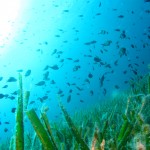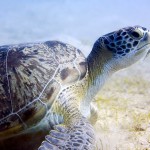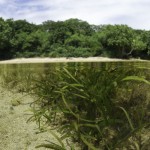Raising the voice for the world’s seagrass on World Oceans Day
Seagrass meadows around the world continue to be under threat from the activities of humans. Over fishing, climate change, coastal development, extreme weather and poor land management are all contributing to the continued global loss of these diverse and productive marine habitats that are critical for the continued functioning of the coastal environment and the services it provides.
Over the last decade a range of publications by leading global scientists have highlighted how governments, communities, industry and global conservation are failing to take the action necessary to prevent the further degradation of these important ecosystem service providers. Recent high profile research publications have shown how individual seagrass species are potentially under threat from extinction, whilst the global area of seagrass is being reduced at a rate of up to two soccer fields per hour.
Seagrass meadows are a valuable means of support for global food security due to their role as critically important nursery habitats for many of the world’s fisheries. They also directly provide fishery habitat and support endangered species such as the dugongs and green turtles. Seagrass meadows bubble oxygen into the water and sediments, sucking carbon dioxide from the atmosphere and cleaning the coastal environment of many pollutants. If current patterns of habitat loss coupled to the increasing influence of climate change are not controlled then the world faces a potentially future devoid of these productive, valuable and diverse habitats.
Not many people know what a seagrass meadow is, but it’s estimated that 1 billion people live within 50 km of one. Today, on World Oceans Day, scientists from the World Seagrass Association are seeking to highlight the value and threats to these meadows so that greater emphasis and resources are placed on their conservation.
To help save seagrasses into the future the World needs to:
- educate people about the importance of seagrasses through ad-hoc awareness programs;
- decrease turbidity in coastal waters by reducing sediment and nutrient loads being released from land;
- make sure boats no longer damage seagrasses via their anchors or propellers;
- prohibit dredging and filling on/nearby areas colonized by seagrasses;
- preserve existing seagrass beds and restore degraded or lost ones; and
- include seagrass ecosystems in coastal management plans or marine protected areas.
General information on seagrass
Seagrasses in South Florida, the Florida Museum of Natural History
Seagrasses at CoSEE (The Centers for Ocean Sciences Education Excellence, University of Maryland Center for Environmental Science
Mediterranean Seagrass Ecosystem at MarBEF (Marine Biodiversity and Ecosystem Functioning)
Key seagrass publications
Unsworth and Cullen (2010). “Recognising the necessity for Indo-Pacific seagrass conservation.” Conservation Letters 3(2): 63-73. Follow the link
Hughes et al (2009). “Associations of concern: declining seagrasses and threatened dependent species.” Frontiers in Ecology and the Environment 7(5): 242-246. Follow the link
Waycott et al. (2009). “Accelerating loss of seagrasses across the globe threatens coastal ecosystems.” Proceedings of the National Academy of Sciences of the United States of America 106(30): 12377-12381. Follow the Link
Duarte et al. (2008). The charisma of coastal ecosystems: addressing the imbalance. Estuaries and Coasts 31: 233–238 Follow the link
Orth et al (2006). A Global Crisis for Seagrass Ecosystems. Bioscience 56: 987–996 Follow the link
Frederick T. Short, Beth Polidoro, Suzanne R. Livingstone, Kent E. Carpenter, Salomão Bandeira, Japar Sidik Bujang, Hilconida P. Calumpong, Tim J.B. Carruthers, Robert G. Coles, William C. Dennison, Paul L.A. Erftemeijer, Miguel D. Fortes, Aaren S. Freeman, T.G. Jagtap, Abu Hena M. Kamal, Gary A. Kendrick, W. Judson Kenworthy, Yayu A. La Nafie, Ichwan M. Nasution, Robert J. Orth, et al. 2011. Extinction risk assessment of the world’s seagrass species. Biological Conservation, 144: 1961-1971


